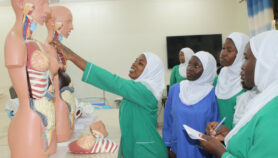By: Edward Tujunirwe
Send to a friend
The details you provide on this page will not be used to send unsolicited email, and will not be sold to a 3rd party. See privacy policy.
A Ugandan S&T ministry would provide the country’s science base with the clarity, cohesion and direction it needs, says Edward Tujunirwe.
Uganda has heard passionate calls from scientists, politicians and the public to establish a Ministry of Science and Technology in the past few months.
These calls have been reflected in several government policies — the country’s National Development Plan, recently endorsed by the cabinet, explicitly asks for a science and technology (S&T) ministry, for example.
And yet there are no signs that this ministry will be created any time soon.
Some critics argue that the move would destabilise the current S&T setup and derail the implementation of key programmes.
But creating an effectively managed S&T ministry could be a real strategic investment. Uganda is the only country in East Africa to operate without such a ministry and if we do not make the move soon, we risk trailing behind in scientific and technological development.
Poor coordination
The government already recognises that S&T are vital in stimulating socioeconomic development. Science education is now compulsory in the first four years of secondary school, and the government prioritises science students at public universities for state funding.
But, more broadly, Uganda’s S&T are characterised by inadequate public and private funding, low levels of new technology development and adoption, and too few staff.
S&T in Uganda are poorly coordinated, with badly administered institutions housed across several ministries and given varying — even conflicting — mandates.
An independent ministry could provide a powerful technical and administrative tool for creating a coherent S&T programme that is more effective, relevant, accessible and productive.
It would enable the government to effectively coordinate and supervise S&T activities, galvanise and consolidate the achievements made so far, and accelerate socioeconomic development.
Ensuring buy-in
But a well-coordinated, functional, S&T system led by an independent minister is impossible without clear leadership, a strong advocacy strategy and consensus among the diverse stakeholders.
Defending the creation of a new ministry will not be easy — Uganda’s development partners, and even the president himself, have already raised concerns about the ever-increasing cost of public administration. A science ministry would push Uganda’s number of ministries over that allowed by the constitution.
A consensus among Ugandan scientists on the need for a new ministry is crucial to overcoming these hurdles.
So is effective political engagement. Only the president has the power to create a new cabinet post — while cabinet members themselves are subject to parliamentary approval, the decision to create (or disband) a ministry is not.
So whether we succeed in advocating for the new S&T ministry will depend in part on how closely the president listens to us. Regrettably, there are few scientists and engineers actively involved in Ugandan politics — even fewer that have the president’s ear — and not all those that are agree a new ministry is necessary.
As scientists, we can only assist our leader by providing him with timely, reliable and credible information. The decision to act (or not) will be his alone but we cannot expect him to act in our favour if we cannot reach consensus or ensure our voices are heard.
On the plus side, the president has often alluded to the need to strengthen Ugandan S&T and publicly complained about ‘bottlenecks’ in the system. He has also personally initiated several well-intentioned schemes, including the Presidential Initiative on Banana Industrial Development, the Presidential Support to Scientists programme and the Uganda Millennium Science Initiative.
What we need now is a ministry — ideally led by the president himself for at least the first five years — to oversee and manage the national S&T environment in the country.
Learning by example
We need not reinvent the wheel — more than 100 countries around the world have S&T ministries and many are making real progress, including those in India, Israel and South Africa.
A close evaluation of these would inform our strategy.
We can, and should, learn from the choices made by others. That doesn’t mean we should import their models wholesale. Rather, we must skilfully and strategically adjust these to address our national concerns and priorities.
S&T are vital for socioeconomic development and form the backbone of many developed countries. It is time for Uganda to follow in their footsteps and for our government to create the environment for a new and promising future guided by scientific and technological independence and sustainability.
Establishing an independent and effective ministry of S&T would be a crucial move in this direction.
Edward Tujunirwe is science officer and head of corporate and international affairs at the Uganda National Council for Science and Technology.













